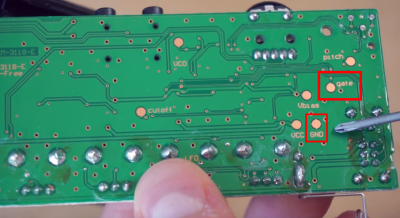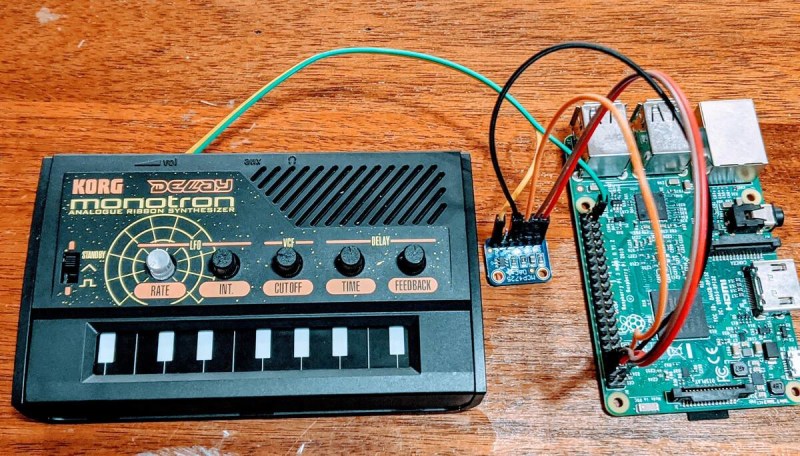There are a handful of relatively dirt cheap synths out there like the KORG Monotron, but many of them use ribbon controllers that aren’t very precise. Ribbon controllers basically slide pots that you operate with your finger or a stylus. They’re painted to look like piano keys in order to show you approximately where the notes are supposed to be. The Stylophone is another extremely affordable synth that does even less as a synthesizer and uses this type of input. It’s a fun input if you don’t mind imprecision, but can be annoying otherwise.
 [schollz] isn’t satisfied to synth this way, so they added MIDI input to their KORG Monotron using a Raspberry Pi and a DAC. Fortunately, the Monotron is quite the hackable little synth, with nice, big, labelled pads on the PCB.
[schollz] isn’t satisfied to synth this way, so they added MIDI input to their KORG Monotron using a Raspberry Pi and a DAC. Fortunately, the Monotron is quite the hackable little synth, with nice, big, labelled pads on the PCB.
All it really took was a couple of solder joints in the right places, plus a clever Python script. The script listens for MIDI input from a keyboard, and then controls an MCP4725 DAC, which sends voltages to the Monotron. [schollz] wrote a tuning function that computes the FFT of the MIDI tones to find the fundamental frequencies of each to send along to the Monotron. Check it out after the break.
If liquid control is what you’re after but all you have is a keyboard, try making your own ribbon controller.
Via adafruit
















In 1976 McGill university had an electronic music studio. A Moog, a Mellotron, I can’t remember what else. But, the Moog a big early model, had no keyboard. Just a ribbon controller. Someone said because the professor didn’t want students to play “normal” music. Not that you could do much with a single voice synthesizer with no presets.
You would be amazed on what you can do with a single-voice synthesizer with no presets.. There are no presets to limit your imagination!
The Moog Mother32 is an affordable standlone-synth(but with a keyboard, kind-of and MIDI), there’s VCV-Rack.. Try it out and limit yourself to a simple setup with one oscillator, filter, envelope and LFO, each and maybe a couple of mults.
Soon you’ll find sounds from bass to melody to percussion all in that very simple setup.
Single voice synths with no presets are currently quite popular (Arturia, Doepfer, Moog – just to name few big players on the market) and you can do a lot with them. There is even entire album done with Minimoog only. Check youtube for Jexus demos of Moog Sub Phatty or Polivox just for start. And if you don’t like synths there is erhu (asian violin), flute or even human voice to check. Or simply find “chicken in a corn” by Brushy One String and enjoy song on one string guitar.
Sure those instruments are difficult to be used solo but they add great value when used combined.
> Not that you could do much with a single voice synthesizer with no presets.
I find the monophonic monotron quite capable! After all, I made a whole album with it: https://infinitedigits.bandcamp.com/album/at-the-place
That’s some great stuff there, schollz! Yes, you can do a lot of music with the minimal amount of equipment. Imagination is more important than equipment!
Impressive. If this was done as youtube video you could get some attention.
Could you provide more details about production process?
Sure! Before the album I recorded myself demoing a couple of the songs. Here’s a few (only ~1 minute each because of instagram):
– https://www.instagram.com/p/CFLd_XcBjcM/
– https://www.instagram.com/p/CFBjBxGhJXs/
– https://www.instagram.com/p/CFD9cW7hrkp/
I should’ve videoed the whole album recording – it only took about 3 hours to record everything actually. Each song was done in one take, but it took 5 or 6 takes to get a good cut :)
Nice work with both music and monotron hack.
Ah. A non-musician. Check…
Here a few VCS-3’s, behringer model D and a polysix of wich only the latter has polyphony and memory. Musical expression does not need memory or polyphony. Saxophone? Trumpet? Recorder?
…stick to bang on something?
two palms?
B^)
https://www.youtube.com/watch?v=VSmD9hrbrF0